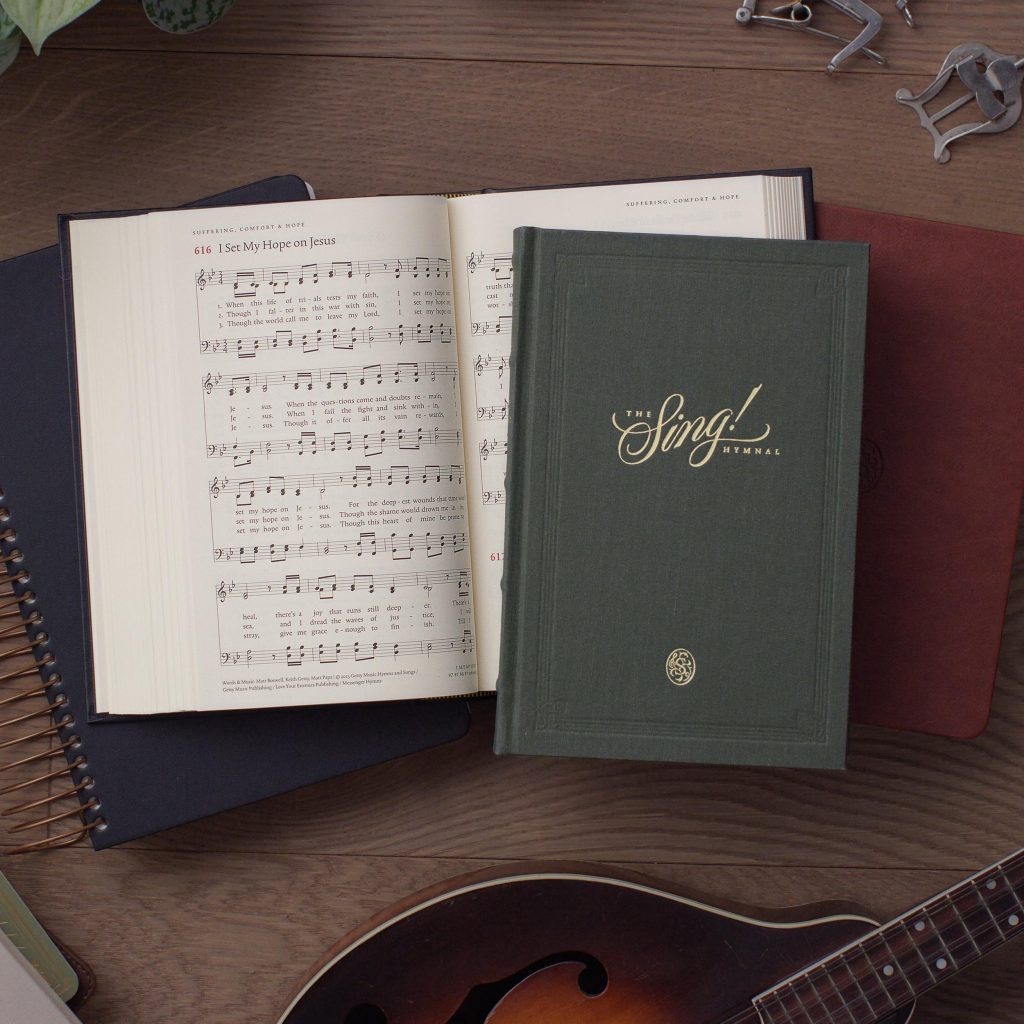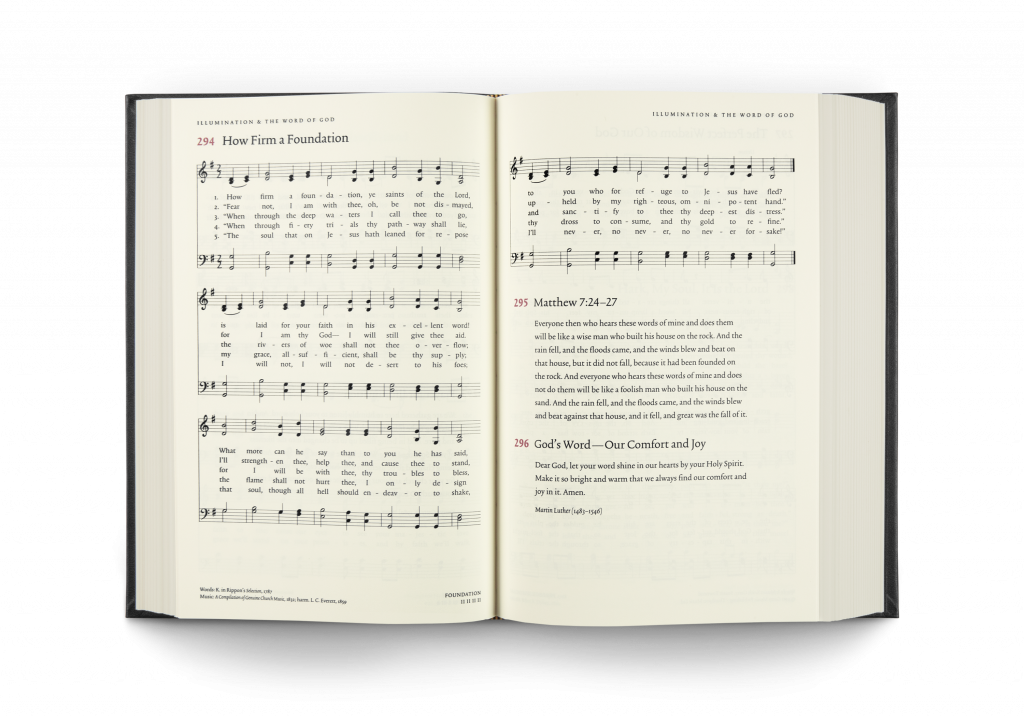About our Hymnal
Introduction
We have inherited a great singing tradition at NSCBC. It is in fact one of the first things I fell in love with at our church when I arrived in 2022. Robust singing as to the Lord is why I do what I do. So when I came to the church and heard the acoustics of the sanctuary, a beautiful grand piano, organ, and choir, I knew I was in for a treat. Three years later, hearing the church sing during worship week after week, I’m grateful and honored to be in the role to steward this singing tradition for this generation.
When I first arrived, I made a few changes with the aim of strengthening congregational participation. Moving the band position to the side reminds us that our focus is chiefly on God in worship, while still being led by musicians and singers. The addition of an entrance/gathering hymn from the organ at the beginning of the service reminds us that our duty from beginning to end is to praise God with all our heart, mind, soul, and strength. And to sing this first hymn we primarily use our hymnal. Why do we use a hymnal? Read here.
After a few years using our current hymnal Hymns for the Living Church, I began to ask the question of whether a hymnal of this generation might be a better tool for our faith formation through worship. In discussion with Pastor Bobby and with budget approval, I set out on gathering a team and researching options.
Preliminary Work & Research
At the beginning of the year, a team was formed to explore selecting a new hymnal for our church. Six men and women joined in the work of hymnal selection representing a diversity of ages and perspectives: Beth Pocock, Michael Bajema, Adam Kurihara, Annalise Nakoneczny, Shannon Read, and Carolyn Oakes Tuck.
We compiled a list of 19 hymnals in current publication that would be worth exploring. Some were omitted immediately due to theological distinctives that would not be beneficial for NSCBC. Others for denominational differences that would distract rather than unify. Ultimately we were intrigued by three hymnal “finalists” to explore further:
- Our Great Redeemers Praise (2022). A hymnal from the Methodist tradition that emphasizes songs from Charles and John Wesley, and hymns from the many traditions born from that movement.
- The Sing! Hymnal (2025). An interdenominational hymnal from modern hymn writers Keith and Kristyn Getty that brings together historic hymns of the faith with newly written hymns from the modern hymn renaissance.
- Trinity Psalter Hymnal (2018). A reformed presbyterian hymnal that emphasizes psalm singing, and a ‘text-first’ approach – emphasizing theologically robust lyrics and then finding the best tunes with which to sing them.
A Collaborative Approach
Our hymn committee met first to ask good questions. What would success look like? How would we know if we got it right?
One goal we identified early on is that the hymnal should serve to get people excited about hymn singing. It will have failed if only the hymn-nerds among us like the result. We went about looking for a hymnal that would be accessible to all, especially children.
We met in June with hymnal editor (and friend of NSCBC) Julie Tennent, who served on the editorial team of Our Great Redeemer’s Praise. She shared with us the vision of that team; how they decided to organize their hymnal around the articles of the Apostles’ Creed, compiled lists from dozens of major hymnals and culled through to find the essential canon of songs, and then focused on the body of hymns from the Wesley brothers, as well as aimed to include songs from the global church, african american traditions, and some contemporary selections.
From this meeting we went away with assignments – each would take a hymnal from our short list to review. At our second meeting in September we gathered to share our results. Again, asking what success might look like.
We agreed that whatever hymnal we chose, it would need to be representative of the whole congregation. It would need to have the classic hymns of the faith (and every hymnal we looked at did) but it should also stretch us into the next generation. “The hymn-book of the church has no back cover” – meaning that whatever we choose, we realize that great hymns are yet to be written. We’ll sing those songs too!
Hymnal reviews were shared, and we had an honest conversation about the benefits and also the drawbacks of each hymnal. On the one hand, it felt like an impossible task – to codify in ink on paper the songs we might sing for the next 40-50 years. What if we got it wrong? I reminded our team that any of these options would be a great selection for our church. Any of these hymnals would inspire praise and teach the faith.
And after a good discussion, one hymnal rose to the top and became our unanimous recommendation.
(drumroll please…)
Announcing Our New Hymnal
The "Sing!" Hymnal
Our committee was impressed most with Crossway’s 2025 release of The Sing! Hymnal and are excited to recommend this for the congregation’s future use. After eight months of reviewing dozens of hymnals, we were drawn to this beautiful and fresh take on the hymn book tradition. It represents a defining moment for the modern hymn renaissance, containing not only the historic hymns of the faith, but also many hymns (155) written in the last few decades. It represents a canonisation of decades of modern hymn writing, many of which we sing in our services, from “In Christ Alone” (2002) to “His Mercy is More,” (2015) and so much more.
A hymnal is a “canon” or collection of hymnody in one place that gathers together hymns from over two thousand years of Christian worship. We want our next hymnal to represent the wide span of authors and musicians from various periods of history and life experience with the Scriptures to show a unified voice of who God is and who we are as his people.
Why we chose this hymnal
A few reasons that stood out to us
A Hymnal for Church and Home
As an intergenerational church, one reason why we loved this hymnal is that it has been designed with the church and home in mind. The hymnal contains a significant section on hymns for children (hymns 335-388). These include NSCBC favorites such as “Jesus Strong and Kind”, classics like “Great is He” and new children’s songs we have yet to sing. The editors also included a brief paragraph ‘hymn story’ for every hymn in an appendix, to aid in worshipping by singing with understanding.
Beauty and Durability
Another reason worth mentioning: it is gorgeous. The layout of musical type on the page, the font and color selections, and the quality of the binding and paper make this hymnal stand out as both beautiful and durable. Indeed the colophon (publishers imprint) at the back states “All text is set in the Trinité typeface, designed by Bram de Does. This hymnal was printed on custom 70gsm acid-free paper. Each physical component was carefully selected, with beauty and durability serving as the guiding principles.”
Our committee felt that this hymnal would not only delight hymn-lovers, but inspire those less inclined toward hymn singing to pick it up, feel its pages, and begin using it regularly in worship. It is easy on the eyes, with plenty of white-space on the page so the eyes are directed to the text and music. At the bottom of each hymn is author information for text and composer information for tune, with dates of writing. This helps us sing while connecting us with a moment in history. Maybe we are singing a hymn of the reformation, or a song from a 20th century revival, or something from today. We sing today’s songs from those who have gone before.
A ‘Light’ Liturgical Emphasis
Since this hymnal was created to be used across denominations, it does not come organized primarily around the liturgical year, but does include a section of songs concerning the life of Christ. This includes sections for Advent, Christmas, Epiphany, Palm Sunday/Holy Week, Easter, Ascension, Pentecost, and Christ’s Return. The observant will notice that Lent is curiously missing, which speaks to the ‘light’ emphasis. While I’m sad to see the section omitted, I’m aware many churches do not observe lent in any way, so that might create more confusion than help.
Other organizational sections of the hymnal include the worship service and the christian life, two sections standard across many hymnals.
A Diversity of Christian Voices
We worship together with saints past and present – joining with their voices outside of time. Interspersed throughout the hymnal are prayers spanning 2 millennia of christian worship. These readings are organized thematically by section which makes for a great resource when planning a worship service. These come from a variety of sources such as early christian liturgies, catechisms, the Book of Common Prayer, and more modern prayer books such as The Valley of Vision and contemporary devotional sources such as Every Moment Holy and New Morning Mercies. The hymnal also includes readings from female voices such as Sally Lloyd Jones (The Jesus Storybook Bible), Kristyn Getty, and Joni Eareckson Tada (When God Weeps, Songs of Suffering)
Conclusion
Our committee is thrilled to recommend this hymnal for the church. If you’ve made it this far, we’re glad you read our words! We hope this hymnal draws all people- men, women, and children – into worship on Sundays and in small groups, in devotional times, at retreats, and more. If you would like to purchase a copy for your home or small group, you can request one from our bookstall here.






